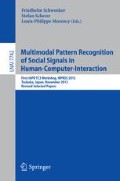Abstract
In this paper, we propose a new framework to assess temporal coordination (synchrony) and content coordination (behavior matching) in dyadic interaction. The synchrony module is dedicated to identify the time lag and possible rhythm between partners. The imitation module aims at assessing the distance between two gestures, based on 1-Class SVM models. These measures discriminate significantly conditions where synchrony or behavior matching occurs from conditions where these phenomenons are absent. Moreover, these measures are unsupervised and could be implemented online.
Access this chapter
Tax calculation will be finalised at checkout
Purchases are for personal use only
Preview
Unable to display preview. Download preview PDF.
References
Delaherche, E., Chetouani, M., Mahdhaoui, A., Saint-Georges, C., Viaux, S., Cohen, D.: Interpersonal synchrony: A survey of evaluation methods across disciplines. IEEE Transactions on Affective Computing 3(3), 349–365 (2012)
Prepin, K., Pelachaud, C.: Shared understanding and synchrony emergence: Synchrony as an indice of the exchange of meaning between dialog partners. In: ICAART 2011 International Conference on Agent and Artificial Intelligence, vol. 2, pp. 25–30 (2011)
Bernieri, F., Rosenthal, R.: Interpersonal coordination: Behavior matching and interactional synchrony. In: Fundamentals of Nonverbal Behavior, pp. 401–432. Cambridge University Press (1991)
Sun, X., Nijholt, A.: Multimodal embodied mimicry in interaction. In: Esposito, A., Vinciarelli, A., Vicsi, K., Pelachaud, C., Nijholt, A. (eds.) Communication and Enactment 2010. LNCS, vol. 6800, pp. 147–153. Springer, Heidelberg (2011)
Chartrand, T.L., Bargh, J.A.: The chameleon effect: The perception-behavior link and social interaction. Journal of Personality and Social Psychology 76(6), 893–910 (1999)
Muir, D., Nadel, J.: Infant social perception. In: Slater, A. (ed.) Perceptual Development, pp. 247–285. Psychology Press (1998)
Murray, L., Trevarthen, C.: Emotional regulation of interactions between two-month-olds and their mothers. In: Field, T.M., Fox, N. (eds.) Social Perception in Infants, pp. 177–197. Ablex, Norwood (1985)
Altmann, U.: Investigation of movement synchrony using windowed cross-lagged regression. In: Esposito, A., et al. (eds.) Communication and Enactment 2010. LNCS, vol. 6800, pp. 335–345. Springer, Heidelberg (2011)
Andry, P., Gaussier, P., Moga, S., Banquet, J., Nadel, J.: Learning and communication in imitation: An autonomous robot perspective. IEEE Transactions on Systems, Man and Cybernetics, Part A 31(5), 431–444 (2001)
Boucenna, S., Gaussier, P., Andry, P.: What should be taught first: the emotional expression or the face? In: 8th International Conference on Epigenetic Robotics (EPIROB), Lucs (2008)
Zhang, J., Marszałek, M., Lazebnik, S., Schmid, C.: Local features and kernels for classification of texture and object categories: a comprehensive study. International Journal of Computer Vision 73(2), 213–238 (2007)
Laptev, I., Marszalek, M., Schmid, C., Rozenfeld, B.: Learning realistic human actions from movies. In: IEEE Conference on Computer Vision and Pattern Recognition (CVPR 2008), pp. 1–8 (June 2008)
Li, F.F., Perona, P.: A bayesian hierarchical model for learning natural scene categories. In: Proceedings of the IEEE Conference on Computer Vision and Pattern Recognition, Washington, DC, USA, pp. 524–531 (2005)
Dollr, P., Rabaud, V., Cottrell, G., Belongie, S.: Behavior recognition via sparse spatio-temporal features. In: VS-PETS, pp. 65–72 (2005)
Canu, S., Smola, A.J.: Kernel methods and the exponential family. Neurocomputing 69, 714–720 (2005)
Schölkopf, B., Platt, J.C., Shawe-Taylor, J.C., Smola, A.J., Williamson, R.C.: Estimating the support of a high-dimensional distribution. Neural Comput. 13(7), 1443–1471 (2001)
Kadri, H., Davy, M., Rabaoui, A., Lachiri, Z., Ellouze, N.: Robust Audio Speaker Segmentation using One Class SVMs. In: Proceedings of the EURASIP EUSIPCO 2008, Suisse (2008)
Prince, C.G., Hollich, G.J., Helder, N.A., Mislivec, E.J., Reddy, A., Salunke, S., Memon, N.: Taking synchrony seriously: A perceptual level model of infant synchrony detection. In: Proceedings of the Fourth International Workshop on Epigenetic Robotics, pp. 89–96 (2004)
Author information
Authors and Affiliations
Editor information
Editors and Affiliations
Rights and permissions
Copyright information
© 2013 Springer-Verlag Berlin Heidelberg
About this paper
Cite this paper
Delaherche, E., Boucenna, S., Karp, K., Michelet, S., Achard, C., Chetouani, M. (2013). Social Coordination Assessment: Distinguishing between Shape and Timing. In: Schwenker, F., Scherer, S., Morency, LP. (eds) Multimodal Pattern Recognition of Social Signals in Human-Computer-Interaction. MPRSS 2012. Lecture Notes in Computer Science(), vol 7742. Springer, Berlin, Heidelberg. https://doi.org/10.1007/978-3-642-37081-6_2
Download citation
DOI: https://doi.org/10.1007/978-3-642-37081-6_2
Publisher Name: Springer, Berlin, Heidelberg
Print ISBN: 978-3-642-37080-9
Online ISBN: 978-3-642-37081-6
eBook Packages: Computer ScienceComputer Science (R0)

